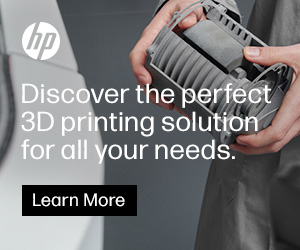HPI Researchers Develop TrussFab 3D Software to Design Strong Structures Using Plastic Bottles and 3D Printed Truss Connectors
![]() When I was in high school, I spent most Saturday nights in the gymnasium with my fellow band friends, playing in the pep band for the basketball games. Since we played during halftime, when most spectators get up to go buy more nachos and stretch their legs, the band members were given a break during third quarter to do those things. But because we were music nerds (and I use that term with no small amount of pride), most of us would also purchase those overpriced 16 ounce bottles of pop and drink a little bit, and progressively more as the quarter went on, while also blowing across the tops of our pop bottles to make different pitches…we were pretty cool. There was also the inevitable bottle flipping, and sometimes people even used the empty bottles as improvised drumsticks. But as soon as the quarter was over, everyone would toss the bottles into the recycling bins and head back in to the gym to play the fight song and “Louie Louie.” At the time, there was very little reason to save the empty bottles. But now that 3D printing technology is everywhere you look these days, empty plastic bottles have been given a new lease on life.
When I was in high school, I spent most Saturday nights in the gymnasium with my fellow band friends, playing in the pep band for the basketball games. Since we played during halftime, when most spectators get up to go buy more nachos and stretch their legs, the band members were given a break during third quarter to do those things. But because we were music nerds (and I use that term with no small amount of pride), most of us would also purchase those overpriced 16 ounce bottles of pop and drink a little bit, and progressively more as the quarter went on, while also blowing across the tops of our pop bottles to make different pitches…we were pretty cool. There was also the inevitable bottle flipping, and sometimes people even used the empty bottles as improvised drumsticks. But as soon as the quarter was over, everyone would toss the bottles into the recycling bins and head back in to the gym to play the fight song and “Louie Louie.” At the time, there was very little reason to save the empty bottles. But now that 3D printing technology is everywhere you look these days, empty plastic bottles have been given a new lease on life.
 These bottles can be used to make printing filament for 3D pens and 3D printers alike, and you can even truss two bottles together with 3D printed parts to make a kite-powered boat. Researchers at Germany’s Hasso-Plattner Institute (HPI), which recently used metamaterials to make both a 3D printed door latch and a 3D printed, PIN-protected door lock, are working on an eco-friendly project to put the bottles to use as building blocks for large objects like a rowboat, chairs, and a domed structure. The research team developed cutting-edge 3D software, called TrussFab, so anyone can build strong structures out of plastic bottles.
These bottles can be used to make printing filament for 3D pens and 3D printers alike, and you can even truss two bottles together with 3D printed parts to make a kite-powered boat. Researchers at Germany’s Hasso-Plattner Institute (HPI), which recently used metamaterials to make both a 3D printed door latch and a 3D printed, PIN-protected door lock, are working on an eco-friendly project to put the bottles to use as building blocks for large objects like a rowboat, chairs, and a domed structure. The research team developed cutting-edge 3D software, called TrussFab, so anyone can build strong structures out of plastic bottles.
Róbert Kovacs, a PhD researcher at HPI’s Human Computer Interaction Lab, told Digital Trends, “Our original motivation came from a desire to increase the capabilities of desktop 3D printers. In particular, we wanted to work out how to create large objects using these machines that normally print much smaller objects. We thought we could do this by creating connectors for joining larger pre-existing objects — and soda bottles seemed to be the perfect choice for that.”
 While most people may look at an empty plastic bottle and note how flimsy and weak it is, the research team discovered that when the bottles are pushed or pulled along their main axis, they’re actually pretty strong. HPI’s TrussFab is an integrated end-to-end system, and users are able to design sturdy, large-scale structures, and then determine the proper distribution of plastic bottles to fabricate a strong end product that can hold human weight, like a bridge or chair. Then, TrussFab brings 3D printing into the mix, to manufacture the pieces which connect the bottles in a strong, honeycomb-like formation.
While most people may look at an empty plastic bottle and note how flimsy and weak it is, the research team discovered that when the bottles are pushed or pulled along their main axis, they’re actually pretty strong. HPI’s TrussFab is an integrated end-to-end system, and users are able to design sturdy, large-scale structures, and then determine the proper distribution of plastic bottles to fabricate a strong end product that can hold human weight, like a bridge or chair. Then, TrussFab brings 3D printing into the mix, to manufacture the pieces which connect the bottles in a strong, honeycomb-like formation.
 TrussFab thinks of the bottles as beams, and not stackable bricks, and uses them to formulate structurally sound node link structures, known as trusses, that are based on closed triangles. This structural arrangement is actually what prevents deformation, and not the individual bottles themselves, which can break easily. Bottles buckle easily when pushed from the sides, but the connecting trusses turn lateral forces, or bending movements, into compression and tension forces along the length of the edges.
TrussFab thinks of the bottles as beams, and not stackable bricks, and uses them to formulate structurally sound node link structures, known as trusses, that are based on closed triangles. This structural arrangement is actually what prevents deformation, and not the individual bottles themselves, which can break easily. Bottles buckle easily when pushed from the sides, but the connecting trusses turn lateral forces, or bending movements, into compression and tension forces along the length of the edges.
The TrussFab workflow goes like this:
- Automatic conversion: TrussFab’s converter can create structures by converting an existing 3D model. This converts the model’s volume into a tetrahedral honeycomb structure, so it can bear a lot of weight.

- Editing: TrussFab’s editor was actually implemented as an extension to SketchUp, and in addition to offering all of the 3D modeling software’s original functionalities, it also helps users create sturdy structures through some added custom functions. For instance, the TrussFab editor offers tools that can create large beams in the form of trusses, tools for tweaking a structure’s shape while keeping the structure intact, and its integrated structural analysis will actually calculate a structure’s internal forces and warn users if it could break.
- Hub generation: The hub generator will generate 3D models of all hubs after structure design is complete, including 3D printable hubs for spatial structures and laser-cuttable 2D hubs for facades.
- Fabrication: Once the hub generator produces the 3D model files, TrussFab users send the files for 3D printing.
- Assembly: TrussFab users can follow the unique IDs embossed into each hub to manually assemble their strong structures.
The team validated the TrussFab system by designing and building tables and chairs, an 8-foot bridge strong enough to carry a person, a functional two-seater boat, and even used 512 plastic bottles to construct a 16.5′ dome. The team plans to make their innovative 3D software available for free soon, so make sure to save your pop bottles!
Kovacs explained, “Our other intention with the project was to encourage recycling. We wanted to make people more aware that the bottles they throw away can be a great source of material, and aren’t just trash. Even the 3D-printed connectors can be produced from recycled materials, which means that the entire structures can be made from plastic bottles in some way.”
The team published a paper on their research project, titled “TrussFab: Fabricating Sturdy Large-Scale Structures on Desktop 3D Printers,” which further details the software and how to use it. Co-authors include Kovacs, Patrick Baudisch, Thomas Bläsius, Maximilian Brehm, Hsiang-Ting Chen, Yannis Kommana, Florian Meinel, Willi Müller, Alexander Popiak, Jonathan Striebel, Anna Seufert, Ludwig Wall, and Sijing You. Discuss in the TrussFab forum at 3DPB.com.
[Source: Digital Trends / Images: HPI]
Subscribe to Our Email Newsletter
Stay up-to-date on all the latest news from the 3D printing industry and receive information and offers from third party vendors.
You May Also Like
3D Printing News Briefs, July 6, 2024: Resellers, Government Grants, & More
We’re starting with material news in 3D Printing News Briefs today, as Dynamism is now offering Tullomer super-polymer filament from Z-Polymers in North America. Then, ADDiTEC unveiled its new Hybrid...
3D Printing News Briefs, June 29, 2024: AI Machine Learning, Sensory Garden, Hard Hats, & More
In 3D Printing News Briefs today, we’re starting with Desktop Metal’s new PureSinter furnace. Then it’s on to research about a variable binder amount algorithm and adaptive slicing, a 3D...
Siemens Increases Attention on US 3D Printing Landscape
Global industrial giant Siemens has announced that the company is taking steps to help bolster the US additive manufacturing (AM) industry. The efforts will surround Siemens’ Charlotte Advanced Technology Collaboration...
Vendor Managed Inventory for 3D Printing Introduced by Authentise
While additive manufacturing (AM) hardware continues to advance, much of the technology is already mature enough for large batch production. With AM Researcher’s “Opportunities in Additive Manufacturing Software Markets 2023”...




































